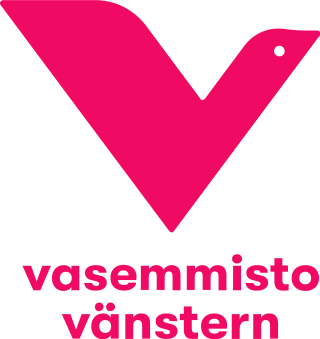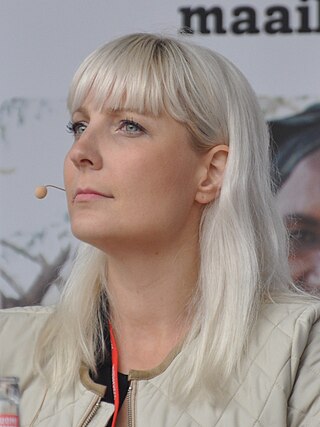| ||
16 seats to the European Parliament | ||
|---|---|---|
The 1996 European Parliament election in Finland was the first election of the Finnish delegation to the European Parliament.
| ||
16 seats to the European Parliament | ||
|---|---|---|
The 1996 European Parliament election in Finland was the first election of the Finnish delegation to the European Parliament.
In 1996, Finland had a population of 5.1 million (4.1 million voters). The government was a broad coalition led by the social democrat Paavo Lipponen. The governing coalition consisted of: the Social Democrats (SDP), The National Coalition Party (Kokoomus), the Left Alliance (Vasemmistoliitto), The Swedish People's Party (SFP) and the Greens (Vihreä liitto). [1]
An asterisk (*) indicates members standing for re-election.
All Finnish citizens that were 18 years old on the election day at the latest, were eligible to vote. They did not have to register as it was done automatically by the authorities. Other citizens of the European Union who had a domicile in Finland on 30 August 1996 were eligible to vote, although they had to register as voters in Finland and confirm that they did not vote in any other member state during the elections in 1994 and 1995, and would not vote in Austria in 1996. [1]
According to the Finnish Population Register Center (Väestörekisterikeskus) there were at the end of August 1996 some 72600 foreigners living in Finland. Biggest national groups willing to vote were citizens of Sweden, Germany and the United Kingdom. The final date for the registration was 15 August 1996.
In June Väestrekisterikeskus approached with an official letter all the EU nationals living in Finland. The letter was in Finnish, Swedish, English, French and German.
In the European elections candidates could be nominated by the registered political parties and citizens' groups. The parties could do the nomination automatically. The other groups had to gather supporting signatures for each of their candidates from each of the four election districts i.e. each candidate must have had 4 x 1000 supporting signatures. This meant that a non-party organization wanting to nominate the maximum number (16) of candidates had to collect 64000 signatures altogether.
The parties and other groups could choose between two different systems. They could nominate candidates for the whole country or for a region. For the elections Finland was divided into four districts. However, all the parties nominated candidates for the whole country.
The deadline for the parties and other organizations to put forward candidates was 19 September 1996. There were 14 parties and one other organization in the elections. The total number of candidates was 207.
| Party | Votes | % | Seats | |
|---|---|---|---|---|
| Centre Party | 548,041 | 24.36 | 4 | |
| Social Democratic Party | 482,577 | 21.45 | 4 | |
| National Coalition Party | 453,729 | 20.17 | 4 | |
| Left Alliance | 236,490 | 10.51 | 2 | |
| Green League | 170,670 | 7.59 | 1 | |
| Swedish People's Party | 129,425 | 5.75 | 1 | |
| Young Finns | 68,134 | 3.03 | 0 | |
| Christian League | 63,279 | 2.81 | 0 | |
| Alternative to the EU | 47,687 | 2.12 | 0 | |
| Finns Party | 15,004 | 0.67 | 0 | |
| Alliance for Free Finland | 13,746 | 0.61 | 0 | |
| Liberal People's Party | 8,305 | 0.37 | 0 | |
| Finnish Pensioners' Party | 6,357 | 0.28 | 0 | |
| Natural Law Party | 3,327 | 0.15 | 0 | |
| Retirees for the People | 2,640 | 0.12 | 0 | |
| Total | 2,249,411 | 100.00 | 16 | |
| Valid votes | 2,249,411 | 95.05 | ||
| Invalid/blank votes | 117,093 | 4.95 | ||
| Total votes | 2,366,504 | 100.00 | ||
| Registered voters/turnout | 4,108,703 | 57.60 | ||
| Source: Tilastokeskus | ||||
The Green League, shortened to the Greens, is a green political party in Finland. Ideologically, the Green League is positioned on the centre-left of the political spectrum. It is a reformist party and it is supportive of feminism, animal rights and green liberal ideas.
The Swedish People's Party of Finland is a Finnish political party founded in 1906. Its primary aim is to represent the interests of the minority Swedish-speaking population of Finland. The party is currently a participant in the Government of Petteri Orpo, holding the posts of Minister of Education, Minister for European Affairs, and Minister of Youth, Sport and Physical Activity.
The National Coalition Party is a liberal-conservative political party in Finland. It is currently the biggest party and the ruling political party of Finland.

The Left Alliance is a socialist political party in Finland.

Paavo Matti Väyrynen is a Finnish politician who, in his long and eventful political career, has served, among other things, as Minister of Foreign Affairs from 1977 to 1982, and again from 1983 to 1987 and from 1991 to 1993. He is a former member of the Finnish Parliament who has represented the Seven Star Movement, the Citizen's Party and Centre Party. He left the Centre Party in 2023.

Helsinki is one of the 13 electoral districts of the Parliament of Finland, the national legislature of Finland. The district was established as Helsinki City in 1954 from parts of Uusimaa Province. It was renamed Helsinki in 1997. It is conterminous with the municipality of Helsinki. The district currently elects 23 of the 200 members of the Parliament of Finland using the open party-list proportional representation electoral system. At the 2023 parliamentary election it had 546,375 registered electors.

Parliamentary elections were held in Finland on 18 March 2007. Early voting was possible from the 7–13 March. The 200 members of the Eduskunta were elected from 15 constituencies.
Parliamentary elections were held in Finland on 20 and 21 March 1983. The elections were widely regarded as a "protest election" because, contrary to expectations, the major parties with the exception of the Social Democratic Party (SDP) performed poorly; the Liberal People's Party (LKP) lost all its seats in the Eduskunta, while the Finnish Rural Party (SMP) more than doubled its seat tally and the Greens won seats for the first time. The SMP's success was credited, at least in part, to voter distaste for some mainstream parties because of political scandals; no significant policy differences emerged in the election campaign. The SDP won 57 seats, the best performance by a party since World War II.
Parliamentary elections were held in Finland on 15 and 16 March 1987.
An election of the delegation from Finland to the European Parliament was held in 2009.

Presidential elections were held in Finland on 16 January 2000, with a second round on 6 February.

Parliamentary elections were held in Finland on 17 April 2011 after the termination of the previous parliamentary term. Advance voting, which included voting by Finnish expatriates, was held between 6 and 12 April with a turnout of 31.2%.

The Social Democratic Party of Finland is a social democratic and pro-European political party in Finland. It is the third largest party in the Parliament of Finland with 43 seats. Founded in 1899 as the Workers' Party of Finland, the SDP is Finland's oldest active political party and has a close relationship with the Central Organisation of Finnish Trade Unions. It is also a member of the Party of European Socialists, Progressive Alliance, Socialist International and SAMAK.
Following the 2011 election, a new government was negotiated between the leading parties of the Finnish parliament.

Presidential elections were held in Finland on 28 January 2018. The incumbent Sauli Niinistö received 63% of the vote and was elected for a second term, avoiding a second round. He received a plurality of the vote in every municipality and a majority in all but 13 municipalities.
In the run-up to the 2023 Finnish parliamentary election, various organisations carried out opinion polling to gauge voting intentions in Finland. Results of such polls are displayed in this list.

An election of the delegation from Finland to the European Parliament took place on 9 June 2024 as part of the 2024 European Parliament election. This was the seventh European Parliament election held in Finland, and the first to take place after Brexit. Finnish voters elected fifteen members to the European Parliament.

Presidential elections were held in Finland on 28 January 2024, with a second round held on 11 February. Voters elected a president of the Republic for a six-year term. Incumbent president Sauli Niinistö was term-limited and ineligible to run for re-election, having served the maximum two terms, ensuring that the president elected would be the country's thirteenth.